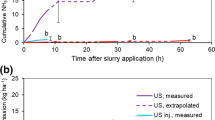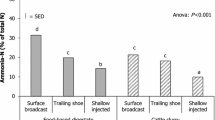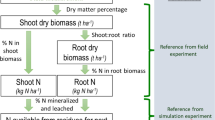Abstract
Ammonia (NH3) emission following the application of livestock slurry to agricultural land is a significant source of atmospheric NH3, and not only poses a risk to the environment through eutrophication and acidification of sensitive ecosystems, but may also result in a loss of plant-available nitrogen (N). The band-spread slurry application technologies of trailing hose and trailing shoe have been shown to reduce NH3 emissions and consequently to increase plant uptake of slurry-applied N. There is a need to improve the precision in calculating the reduction in NH3 emission nationally and at farm level, and this may be achieved through the development of algorithms that more accurately estimate NH3 emission and also support the assessment of fertilizer efficiency of slurry that is band-applied to crops. Therefore, this study reviewed studies of NH3 emission from slurry band applied with a trailing hose or shoe with the objective of developing an algorithm for calculating the reduction efficiency of the band application technique in relation to crop height. The developed algorithm predicted that for slurry applications to cereal crops, the reduction efficiency would increase by slightly less than 1% for every 1 cm increase in crop height. For slurry application to grassland, the reduction efficiency was predicted to increase by approximately 5% for every 1 cm increase in sward height. The developed algorithm was used in combination with the ALFAM model, which predicts NH3 emission from slurry applications to bare soil, to provide monthly coefficients for estimating NH3 emission from slurry applied to bare soil, cereal crops and grassland for Denmark and Southern England. Inclusion of the crop height algorithm in the emission factor derivation predicted, for example, a decrease in the emission factor for cattle slurry application by trailing hose to winter wheat from c. 25% to c. 15% of applied ammoniacal N for applications in January and May, respectively. While the algorithm developed in this study would benefit from wider validation, should more published data become available, the present paper demonstrates its potential value as an educational tool for farmers and advisers in developing more sustainable manure management strategies and for inclusion in emission factor calculations for national inventories to both improve the temporal distribution of emissions from slurry application and to better reflect improved management practices of farmers.
Similar content being viewed by others
References
Andersen J., Sommer S.G., Hansen M.N. (2005) Ammoniakfordampningen i landbruget er overvurderet (Ammonia emisssion from agriculture is overestimated), Landbrugsavisen, Sept. 2005.
Braschkat J., Mannheim T., Marschner H. (1997) Estimation of ammonia losses after application of liquid cattle manure on grassland, Z. Pflanz. Bodenkunde. 160, 117–123.
Chambers B.J., Smith K.A., Pain B.F. (2000) Strategies to encourage better use of nitrogen in animal manures, Soil Use Manage. 16, 157–161.
Denmead O.T., Simpson J.R., Freney J.R. (1977) A direct field measurement of ammonia emission after injection of anhydrous ammonia, Soil Sci. Soc. Am. J. 41, 1001–1004.
Fangmeier A., Hadwiger-Fangmeier A., Van der Eerden L., Jager H.J. (1994) Effect of atmospheric ammonia on vegetation — a review, Environ. Pollut. 86, 43–82.
Hutchings N.J., Sommer S.G., Andersen J.M., Asman W.A.H. (2001) A detailed ammonia emission inventory for Denmark, Atmos. Environ. 35, 1959–1968.
Jackson D.R., Smith K.A. (1997) Animal manure slurries as a source of nitrogen for cereals; effect of application time on efficiency, Soil Use Manage. 13, 75–81.
McGinn S.M., Janzen H.H. (1998) Ammonia sources in agriculture and their measurement, Can. J. Soil Sci. 78, 139–148.
Misselbrook T.H., Hansen M.N. (2001) Field evaluation of the equilibrium concentration technique (JTI method) for measuring ammonia emission from land spread manure or fertiliser, Atmos. Environ. 35, 3761–3768.
Misselbrook T.H., van der Weerden T.J., Pain B.E, Jarvis S.C., Chambers B.J., Smith K.A., Phillips V.R., Demmers T.G.M. (2000) Ammonia emission factors for UK agriculture, Atmos. Environ. 34, 871–880.
Misselbrook T.H., Smith K.A., Johnson R.A., Pain B.F. (2002) Slurry application techniques to reduce ammonia emissions: Results of some UK field-scale experiments, Biosyst. Eng. 81, 313–321.
Misselbrook T.H., Nicholson F.A., Chambers B.J. (2005) Predicting ammonia losses following the application of livestock manure to land, Bioresource Technol. 96, 159–168.
Moal J.F., Martinez J., Guiziou F., Coste C.M. (1995) Ammonia volatilization following surface-applied pig and cattle slurry in France, J. Agr. Sci. 125, 245–252.
Olesen J.E., Scheide K., Weiske A., Weisbjerg M.R., Asman W.A.H., Djurhuus J. (2006) Modelling greenhouse gas emissions from European conventional and organic dairy farms, Agr. Ecosyst. Environ. 112, 207–220.
Rodhe L., Johansson S. (1996) Urin-spridningsteknik, ammoniakavgang och äxtnäringsutnyttjande (Ammonia emission and nutrient utilization from urine using different techniques for application) JTI-rapport, Landbruk & Industri No. 217. Jordbrukstekniska institutet, S-Uppsala, p. 107.
Statistical Analysis System (1989) SAS/STAT Users Guide, Version 6, 4th ed., Vol. 2, SAS Institute, Cary, NC.
Sommer S.G., Olesen J.E. (2000) Modelling ammonia volatilization from livestock slurry trailing hose applied to cereals, Atmos. Environ. 34, 2361–2372.
Sommer S.G., Friis E., Bach A., Schjørring J.K. (1997) Ammonia volatilization from pig slurry applied with trailing hoses or broad-spread to winter wheat: Effects of crop developmental stage, microclimate and leaf ammonia absorption, J. Environ. Qual. 26, 1153–1160.
Sommer S.G., Génermont S., Cellier P., Hutchings N.J., Olesen J.E., Morvan T. (2003) Processes controlling ammonia emission from livestock slurry in the field, Eur. J. Agron. 19, 465–486.
Sommer S.G., Schjørring J.K., Denmead O.T. (2004) Ammonia volatilization from mineral fertilizers and plants in fields ammended with ammoniacal fertilizers, Adv. Agron. 82, 557–662.
Svensson L. (1994) A new dynamic chamber technique for measuring ammonia emissions from land-spread manure and fertilizers, Acta Agr. Scand. B-S.P. 44, 35–46.
Søgaard H.T., Sommer S.G., Hutchings N.J., Huijsmans J.F.M., Bussink D.W., Nicholson F. (2002) Ammonia volatilization from field applied livestock slurry — The ALFAM Model, Atmos. Environ. 36, 3309–3319.
Thomsen I.K., Hansen J.E, Kjellerup V., Christensen B.T. (1993) Effects of cropping system and rates of nitrogen in animal slurry and mineral fertilizer on nitrate leaching from a sandy loam, Soil Use Manage. 9, 53–58.
Webb J., Misselbrook T.H. (2004) A mass-flow model of ammonia emissions from UK livestock production, Atmos. Environ. 38, 2163–2176.
Wilson J.D., Catchpole V.R., Denmead O.T., Thurtell G.W. (1983) Verification of a simple micrometeorological method for estimating the rate of gaseous mass transfer from the ground to the atmosphere, Agr. Meteorol. 29, 183–189.
Author information
Authors and Affiliations
Corresponding author
About this article
Cite this article
Thorman, R.E., Hansen, M.N., Misselbrook, T.H. et al. Algorithm for estimating the crop height effect on ammonia emission from slurry applied to cereal fields and grassland. Agron. Sustain. Dev. 28, 373–378 (2008). https://doi.org/10.1051/agro:2008013
Accepted:
Issue Date:
DOI: https://doi.org/10.1051/agro:2008013




